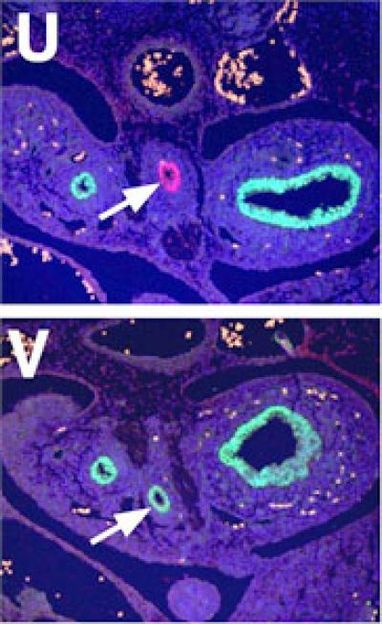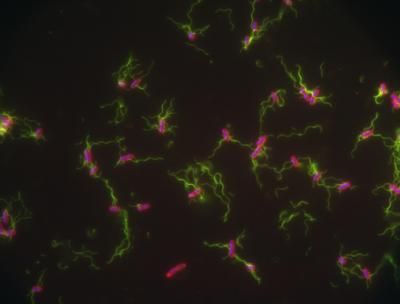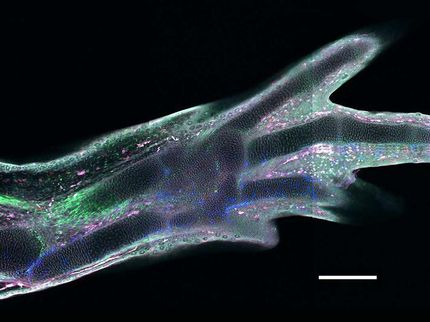How to make a lung
Advertisement
A tissue-repair-and-regeneration pathway in the human body, including wound healing, is essential for the early lung to develop properly. Genetically engineered mice fail to develop lungs when two molecules in this pathway, Wnt2 and Wnt2b, are knocked out. The findings are described in Developmental Cell .

This shows normal and separate expression of Nkx2.1 (green) in lung endoderm and p63 (red) in esophagus endoderm (arrow) (Panel U). Activation of Wnt/beta-catenin results in reprogramming of esophagus endoderm to Nkx2.1 positive lung endoderm (panel V, arrow).
Edward Morrisey, PhD, University of Pennsylvania School of Medicine; Developmental Cell
"We wanted to know the answer to a seemingly simple question: What is required to generate the lung in mammals?" asked senior author Edward Morrisey, PhD, Associate Professor of Medicine and Cell and Developmental Biology at the University of Pennsylvania School of Medicine.
"Wnt molecules are important for lung growth and we think that some of the molecules in the Wnt pathway are needed to specify lung progenitor cells and if not enough cells are 'told' to make a lung, an animal develops a faulty, smaller organ or even no lung," says Morrisey, who is also the Scientific Director of the Penn Institute for Regenerative Medicine.
Several molecular signals are important for proper lung development but not much is known about the early signals that turn on the genes needed to specify the lung at the right place and time in the embryo. Clinically, understanding how a lung develops is important in treating or preventing a host of lung and pulmonary diseases in children. "Premature babies in particular often develop respiratory problems which can lead to health issues not only during infancy but also later in life" says Morrisey.
He also points out that pulmonary and cardiac development is intricately connected. In the developing embryo, the lung, pancreas, liver, thyroid, and stomach all come from the foregut region, which starts out looking like a long tube. "These organs bud from this undifferentiated tube and go on to develop into specific tissue types," explains Morrisey. "The lung is one of the last to bud off the foregut during development."
The team focused on the Wnt pathway to see where and when Wnt molecules were expressed along the foregut tube, even before the lung starts to become a recognizable organ. Morrisey surmised that Wnt2 and Wnt2b were required to specify the early progenitors for the lung in the foregut. "We found that the Nkx2.1 gene, which is expressed in both lung and thyroid progenitor cells in the foregut, were absent only in the region where the lung was supposed to form and not in the thyroid progenitor cells."
They confirmed this fine tuning of lung development by knocking out an additional gene in the Wnt pathway called beta-catenin in the early foregut, and these mice also did not develop lungs, but all the other foregut-associated organs developed properly. "This says that these two Wnt molecules are essential for specifying the lung but not other foregut-derived organs" explains Morrisey.
The Morrisey lab also showed that activation of the Wnt pathway resulted in formation of lung progenitors in both the esophagus and stomach where they are normally excluded. "The ability of Wnt to program esophagus and stomach endoderm to a lung fate points to the critical role this pathway plays in lung development and suggests the possible use of Wnt in generating lung epithelium from non-lung sources."
















































